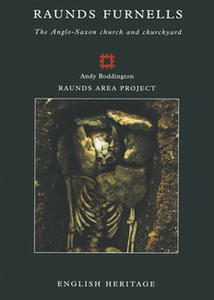English Heritage Archaeological Monographs
English Heritage, 2014. https://doi.org/10.5284/1028203. How to cite using this DOI
Data copyright © English Heritage unless otherwise stated
This work is licensed under the ADS Terms of Use and Access.
Primary contact
Historic England
The Engine House
Firefly Avenue
Swindon
SN2 2EH
Resource identifiers
- ADS Collection: 1416
- DOI:https://doi.org/10.5284/1028203
- How to cite using this DOI
Raunds Furnells: The Anglo-Saxon church and churchyard
Boddington, A., Cramp, R., Cadman, G.
English Heritage (1996)
Abstract:

On the south side of the river Nene in east Northamptonshire, a settlement was established at Raunds in the sixth century AD. Some 300 years later the settlements was served by a small field church. Total and careful excavation ahead of twentieth-century building development found in both the church and adjoining cemetery exceptional features the study of which has contributed to the archaeology of the churches, of the liturgy, and the burial practices of the Anglo-Saxon period. The seeming simplicity of the church's beginnings was deceptive. Before the first church building had been standing long, it proved too small: a chancel was added. Liturgical features were found which did not often survive elsewhere (a pot, used as a sacrarium, buried in front of the free-standing altar, and behind the altar, a clergy bench). The boundaries of a graveyard were established around the church. Many of the earliest burials were preserved, undisturbed by later inhumation. The congregation buried its dead in ordered zones, the earliest dominated by a plot, perhaps a 'founder's grave', distinguished by an elaborately carved stone grave cover, possibly also be a standing cross. In the last years of the graveyard's use, burials of young children took place in an 'eaves-drip' zone flanking the church walls. Much information was retrieved about the population who for two centuries used the church, about their physical health, and about their very varied burial practices. Although a larger church was later built on the site, it was soon abandoned, and subsequently adapted for secular use as part of a 'manorial complex'. The site of the graveyard was forgotten.
Download monograph
| Raunds Furnells: The Anglo-Saxon church and churchyard, Boddington, A.|Cramp, R.|Cadman, G., English Heritage (1996), ISBN: 9781848021969 | 28 Mb |





